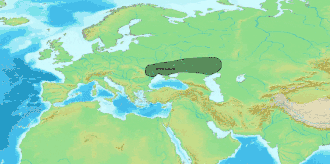Suvorovo culture
The Suvorovo culture, also called the Suvorovo group, was a Copper Age culture which flourished on the northwest Pontic steppe and the lower Danube from 4500 BC to 4100 BC.
 | |
| Geographical range | Northwest Pontic steppe and the lower Danube |
|---|---|
| Period | Copper Age |
| Dates | ca. 4500–4100 BC |
| Preceded by | Sredny Stog culture |
| Followed by | ? |
| Part of a series on |
| Indo-European topics |
|---|
 |
The Suvorovo culture is entirely defined by its burials. These include kurgans and flat graves. Burials are oriented towards the east or northeast, in a supine position with legs either flexed or extended. Roofs of the burial chambers are often covered with stone slabs or logs.
At the Suvorovo site itself a burial of a male and female in a joint grave was found. The male was buried with a "horse-head" scepter in stone. Under the same kurgan two other burials were found. The base of the kurgan was formed by a stone kerb of 13 m in diameter.
Typical grave goods of the Suvorovo culture include ceramics both the Gumelnița–Karanovo culture and the Cucuteni–Trypillia culture, and shell-tempered wares that are typical of the steppe. The Suvorovo kurgans are the earliest ones to appear in Southeast Europe. Its features are characteristic of cultures on the steppes and forest-steppes further east in Ukraine and southern Russia. In accordance with the Kurgan hypothesis, the Suvorovo culture is evidence of a westward expansion of early Indo-European peoples from their homeland on the steppe.
See also
| Wikimedia Commons has media related to Suvorovo culture. |
Sources
- Mallory, J. P.; Adams, Douglas Q. (1997). "Suvorovo culture". Encyclopedia of Indo-European Culture. Taylor & Francis. pp. 556–557. ISBN 1884964982.CS1 maint: ref=harv (link)